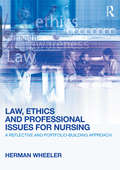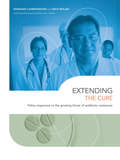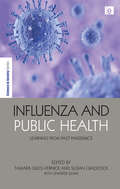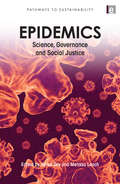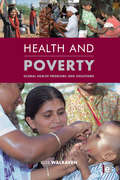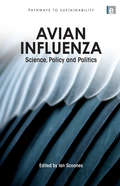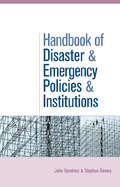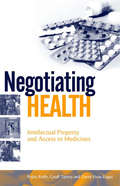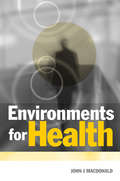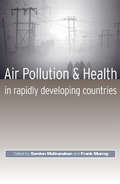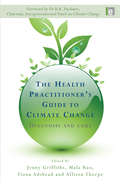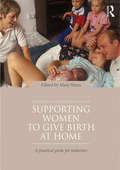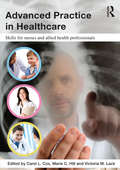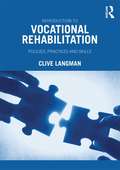- Table View
- List View
Law, Ethics and Professional Issues for Nursing: A Reflective and Portfolio-Building Approach
by Herman WheelerThis comprehensive new textbook covers core ethical and legal content for pre-registration nursing students. It provides readers with a sound understanding of the interrelationships between the NMC's code of conduct, standards and competencies, ethics and relevant sections of the English legal system. The only truly integrated text in the field, it opens with overviews of law and nursing, and ethical theories and nursing. It goes on to explore key areas of contention – such as negligence, confidentiality and consent – from legal and ethical perspectives, mapping the discussion onto the NMC code of conduct. The chapters include objectives, patient-focused case scenarios, key points, activities, questions, areas for reflection, further reading and a summary. Case law and statutes and ethical theories are presented where appropriate. Written by an experienced nurse-lecturer with a law and ethics teaching background, Law, Ethics and Professional Issues for Nursing is essential reading for all pre-registration nursing students, as well as students of other healthcare professions.
Law, Ethics and Professional Issues for Nursing: A Reflective and Portfolio-Building Approach
by Herman WheelerThis comprehensive new textbook covers core ethical and legal content for pre-registration nursing students. It provides readers with a sound understanding of the interrelationships between the NMC's code of conduct, standards and competencies, ethics and relevant sections of the English legal system. The only truly integrated text in the field, it opens with overviews of law and nursing, and ethical theories and nursing. It goes on to explore key areas of contention – such as negligence, confidentiality and consent – from legal and ethical perspectives, mapping the discussion onto the NMC code of conduct. The chapters include objectives, patient-focused case scenarios, key points, activities, questions, areas for reflection, further reading and a summary. Case law and statutes and ethical theories are presented where appropriate. Written by an experienced nurse-lecturer with a law and ethics teaching background, Law, Ethics and Professional Issues for Nursing is essential reading for all pre-registration nursing students, as well as students of other healthcare professions.
Extending the Cure: Policy Responses to the Growing Threat of Antibiotic Resistance
by Ramanan Professor Laxminarayan Anup Professor Malani David Professor Howard David L. SmithOur ability to treat common bacterial infections with antibiotics goes back only 65 years. However, the authors of this report make it clear that sustaining a supply of effective and affordable antibiotics cannot be without changes to the incentives facing patients, physicians, hospitals, insurers, and pharmaceutical manufacturers. In fact, increasing resistance to these drugs is already exacting a terrible price. Every day in the United States, approximately 172 men, women, and children die from infections caused by antibiotic-resistant bacteria in hospitals alone. Beyond those deaths, antibiotic resistance is costing billions of dollars through prolonged hospital stays and the need for doctors to resort to ever more costly drugs to use as substitute treatments. Extending the Cure presents the problem of antibiotic resistance as a conflict between individual decision makers and their short-term interest and the interest of society as a whole, in both present and future: The effort that doctors make to please each patient by prescribing a drug when it might not be properly indicated, poor monitoring of discharged patients to ensure that they do not transmit drug-resistant pathogens to other persons, excesses in the marketing of new antibiotics, and the broad overuse of antibiotics all contribute to the development and spread of antibiotic-resistant bacteria. The book explores a range of policy options that would encourage patients, health care providers, and managed care organizations to serve as more responsible stewards of existing antibiotics as well as proposals that would give pharmaceutical firms greater incentives to develop new antibiotics and avoid overselling. If the problem continues unaddressed, antibiotic resistance has the potential to derail the health care system and return us to a world where people of all ages routinely die from simple infections. As a basis for future research and a spur to a critically important dialogue, Extending the Cure is a fundamental first step in addressing this public health crisis. The Extending the Cure project is funded in part by the Robert Wood Johnson Foundation through its Pioneer Portfolio.
Extending the Cure: Policy Responses to the Growing Threat of Antibiotic Resistance
by Ramanan Professor Laxminarayan Anup Professor Malani David Professor Howard David L. SmithOur ability to treat common bacterial infections with antibiotics goes back only 65 years. However, the authors of this report make it clear that sustaining a supply of effective and affordable antibiotics cannot be without changes to the incentives facing patients, physicians, hospitals, insurers, and pharmaceutical manufacturers. In fact, increasing resistance to these drugs is already exacting a terrible price. Every day in the United States, approximately 172 men, women, and children die from infections caused by antibiotic-resistant bacteria in hospitals alone. Beyond those deaths, antibiotic resistance is costing billions of dollars through prolonged hospital stays and the need for doctors to resort to ever more costly drugs to use as substitute treatments. Extending the Cure presents the problem of antibiotic resistance as a conflict between individual decision makers and their short-term interest and the interest of society as a whole, in both present and future: The effort that doctors make to please each patient by prescribing a drug when it might not be properly indicated, poor monitoring of discharged patients to ensure that they do not transmit drug-resistant pathogens to other persons, excesses in the marketing of new antibiotics, and the broad overuse of antibiotics all contribute to the development and spread of antibiotic-resistant bacteria. The book explores a range of policy options that would encourage patients, health care providers, and managed care organizations to serve as more responsible stewards of existing antibiotics as well as proposals that would give pharmaceutical firms greater incentives to develop new antibiotics and avoid overselling. If the problem continues unaddressed, antibiotic resistance has the potential to derail the health care system and return us to a world where people of all ages routinely die from simple infections. As a basis for future research and a spur to a critically important dialogue, Extending the Cure is a fundamental first step in addressing this public health crisis. The Extending the Cure project is funded in part by the Robert Wood Johnson Foundation through its Pioneer Portfolio.
Influenza and Public Health: Learning from Past Pandemics
by Jennifer Gunn Tamara Giles-Vernick Susan CraddockMajor influenza pandemics pose a constant threat. As evidenced by recent H5N1 avian flu and novel H1N1, influenza outbreaks can come in close succession, yet differ in their transmission and impact. With accelerated levels of commercial and population mobility, new forms of flu virus can also spread across the globe with unprecedented speed. Responding quickly and adequately to each outbreak becomes imperative on the part of governments and global public health organizations, but the difficulties of doing so are legion. One tool for pandemic planning is analysis of responses to past pandemics that provide insight into productive ways forward. This book investigates past influenza pandemics in light of today's, so as to afford critical insights into possible transmission patterns, experiences, mistakes, and interventions. It explores several pandemics over the past century, from the infamous 1918 Spanish Influenza, the avian flu epidemic of 2003, and the novel H1N1 pandemic of 2009, to lesser-known outbreaks such as the 1889-90 influenza pandemic and the Hong Kong Flu of 1968. Contributors to the volume examine cases from a wide range of disciplines, including history, sociology, epidemiology, virology, geography, and public health, identifying patterns that cut across pandemics in order to guide contemporary responses to infectious outbreaks.
Influenza and Public Health: Learning from Past Pandemics
by Jennifer Gunn Tamara Giles-Vernick Susan CraddockMajor influenza pandemics pose a constant threat. As evidenced by recent H5N1 avian flu and novel H1N1, influenza outbreaks can come in close succession, yet differ in their transmission and impact. With accelerated levels of commercial and population mobility, new forms of flu virus can also spread across the globe with unprecedented speed. Responding quickly and adequately to each outbreak becomes imperative on the part of governments and global public health organizations, but the difficulties of doing so are legion. One tool for pandemic planning is analysis of responses to past pandemics that provide insight into productive ways forward. This book investigates past influenza pandemics in light of today's, so as to afford critical insights into possible transmission patterns, experiences, mistakes, and interventions. It explores several pandemics over the past century, from the infamous 1918 Spanish Influenza, the avian flu epidemic of 2003, and the novel H1N1 pandemic of 2009, to lesser-known outbreaks such as the 1889-90 influenza pandemic and the Hong Kong Flu of 1968. Contributors to the volume examine cases from a wide range of disciplines, including history, sociology, epidemiology, virology, geography, and public health, identifying patterns that cut across pandemics in order to guide contemporary responses to infectious outbreaks.
Epidemics: "Science, Governance and Social Justice"
by Sarah Dry Melissa LeachRecent disease events such as SARS, H1N1 and avian influenza, and haemorrhagic fevers have focussed policy and public concern as never before on epidemics and so-called 'emerging infectious diseases'. Understanding and responding to these often unpredictable events have become major challenges for local, national and international bodies. All too often, responses can become restricted by implicit assumptions about who or what is to blame that may not capture the dynamics and uncertainties at play in the multi-scale interactions of people, animals and microbes. As a result, policies intended to forestall epidemics may fail, and may even further threaten health, livelihoods and human rights. The book takes a unique approach by focusing on how different policy-makers, scientists, and local populations construct alternative narratives-accounts of the causes and appropriate responses to outbreaks- about epidemics at the global, national and local level. The contrast between emergency-oriented, top-down responses to what are perceived as potentially global outbreaks and longer-term approaches to diseases, such as AIDS, which may now be considered endemic, is highlighted. Case studies-on avian influenza, SARS, obesity, H1N1 influenza, HIV/AIDS, tuberculosis, and haemorrhagic fevers-cover a broad historical, geographical and biological range. As this book explores, it is often the most vulnerable members of a population-the poor, the social excluded and the already ill-who are likely to suffer most from epidemic diseases. At the same time, they may be less likely to benefit from responses that may be designed from a global perspective that neglects social, ecological and political conditions on the ground. This book aims to bring the focus back to these marginal populations to reveal the often unintended consequences of current policy responses to epidemics. Important implications emerge - for how epidemics are thought about and represented; for how surveillance and response is designed; and for whose knowledge and perspectives should be included. Published in association with the Economic and Social Research Council (ESRC)
Epidemics: "Science, Governance and Social Justice"
by Sarah Dry Melissa LeachRecent disease events such as SARS, H1N1 and avian influenza, and haemorrhagic fevers have focussed policy and public concern as never before on epidemics and so-called 'emerging infectious diseases'. Understanding and responding to these often unpredictable events have become major challenges for local, national and international bodies. All too often, responses can become restricted by implicit assumptions about who or what is to blame that may not capture the dynamics and uncertainties at play in the multi-scale interactions of people, animals and microbes. As a result, policies intended to forestall epidemics may fail, and may even further threaten health, livelihoods and human rights. The book takes a unique approach by focusing on how different policy-makers, scientists, and local populations construct alternative narratives-accounts of the causes and appropriate responses to outbreaks- about epidemics at the global, national and local level. The contrast between emergency-oriented, top-down responses to what are perceived as potentially global outbreaks and longer-term approaches to diseases, such as AIDS, which may now be considered endemic, is highlighted. Case studies-on avian influenza, SARS, obesity, H1N1 influenza, HIV/AIDS, tuberculosis, and haemorrhagic fevers-cover a broad historical, geographical and biological range. As this book explores, it is often the most vulnerable members of a population-the poor, the social excluded and the already ill-who are likely to suffer most from epidemic diseases. At the same time, they may be less likely to benefit from responses that may be designed from a global perspective that neglects social, ecological and political conditions on the ground. This book aims to bring the focus back to these marginal populations to reveal the often unintended consequences of current policy responses to epidemics. Important implications emerge - for how epidemics are thought about and represented; for how surveillance and response is designed; and for whose knowledge and perspectives should be included. Published in association with the Economic and Social Research Council (ESRC)
Health and Poverty: Global Health Problems and Solutions
by Gijs WalravenThere is growing interest and concern about the unacceptable differentials in health between and within countries. This comes out of the realization that poor people will only be able to prosper, and emerge from poverty, if they enjoy better health. Healthy populations are a precondition for sustainable development. Using a novel combination of the personal studies of patients and description of conditions or diseases, this book provides a highly original and accessible introduction to key issues in global health today. Especially during the past decade, global health initiatives have become a prominent part of the international aid picture, bringing new resources, political commitment, and more attention for international health issues in the media. The author provides examples of diseases and problems related to health that disproportionally impact the poor, and gives their experiences 'a human face' through individual case studies. A specific case study of a health problem, such as malaria, tuberculosis and HIV or health financing, introduces each chapter and is followed by a historical review of the problem, why it is still now a problem for poor people or poor countries, and what can be done about it. These will inspire the reader to become more engaged with international health and development.
Health and Poverty: Global Health Problems and Solutions
by Gijs WalravenThere is growing interest and concern about the unacceptable differentials in health between and within countries. This comes out of the realization that poor people will only be able to prosper, and emerge from poverty, if they enjoy better health. Healthy populations are a precondition for sustainable development. Using a novel combination of the personal studies of patients and description of conditions or diseases, this book provides a highly original and accessible introduction to key issues in global health today. Especially during the past decade, global health initiatives have become a prominent part of the international aid picture, bringing new resources, political commitment, and more attention for international health issues in the media. The author provides examples of diseases and problems related to health that disproportionally impact the poor, and gives their experiences 'a human face' through individual case studies. A specific case study of a health problem, such as malaria, tuberculosis and HIV or health financing, introduces each chapter and is followed by a historical review of the problem, why it is still now a problem for poor people or poor countries, and what can be done about it. These will inspire the reader to become more engaged with international health and development.
Avian Influenza: "Science, Policy and Politics"
by Ian ScoonesOver the past decade, substantial resources have been spent on tackling avian influenza and building a global capacity for a pandemic response. The catastrophic costs of the 1918 influenza pandemic are well documented, and the swine flu pandemic of 2009-10 has raised the alarm yet again. Across the world, surveillance systems have been upgraded, stockpiles of antiviral drugs and influenza vaccines have been created, veterinary and public health systems have been improved and poultry production and marketing has been dramatically restructured. What are the lessons from this experience? And what does this suggest for the future? This book explores how virus genetics, ecology and epidemiology intersect with economic, political and policy processes in a variety of places - from Bangkok to Washington, to Jakarta, Cairo, Rome and London. It focuses on the interaction of the international and national responses - and in particular the experiences of Cambodia, Vietnam, Indonesia and Thailand. It asks how effective is the disease surveillance and response system - can it respond to a new pandemic threat? The comparative analysis reveals the challenges and limitations of a technocratic, centralised response, and the need to take seriously local contexts. Drawing from these experiences, the book concludes with a discussion of future prospects and challenges, examining in particular what a 'One World, One Health' approach - where approaches to animal, human and ecosystem health are integrated - would look like in practice. Published in association with the Economic and Social Research Council (ESRC)
Avian Influenza: "Science, Policy and Politics"
by Ian ScoonesOver the past decade, substantial resources have been spent on tackling avian influenza and building a global capacity for a pandemic response. The catastrophic costs of the 1918 influenza pandemic are well documented, and the swine flu pandemic of 2009-10 has raised the alarm yet again. Across the world, surveillance systems have been upgraded, stockpiles of antiviral drugs and influenza vaccines have been created, veterinary and public health systems have been improved and poultry production and marketing has been dramatically restructured. What are the lessons from this experience? And what does this suggest for the future? This book explores how virus genetics, ecology and epidemiology intersect with economic, political and policy processes in a variety of places - from Bangkok to Washington, to Jakarta, Cairo, Rome and London. It focuses on the interaction of the international and national responses - and in particular the experiences of Cambodia, Vietnam, Indonesia and Thailand. It asks how effective is the disease surveillance and response system - can it respond to a new pandemic threat? The comparative analysis reveals the challenges and limitations of a technocratic, centralised response, and the need to take seriously local contexts. Drawing from these experiences, the book concludes with a discussion of future prospects and challenges, examining in particular what a 'One World, One Health' approach - where approaches to animal, human and ecosystem health are integrated - would look like in practice. Published in association with the Economic and Social Research Council (ESRC)
The Handbook of Disaster and Emergency Policies and Institutions
by John Handmer Stephen DoversDisasters both natural and human-induced are leading to spiralling costs in terms of human lives, lost livelihoods and damaged assets and businesses. Yet these consequences and the financial and human crises that follow catastrophes can often be traced to policies unsuited to the emerging scales of the problems they confront, and the lack of institutional capacity to implement planning and prevention or to manage disasters. This book seeks to overcome this mismatch and to guide development of a policy and institutional framework. For the first time it brings together into a coherent framework the insights of public policy, institutional design and emergency and disaster management.
The Handbook of Disaster and Emergency Policies and Institutions
by John Handmer Stephen DoversDisasters both natural and human-induced are leading to spiralling costs in terms of human lives, lost livelihoods and damaged assets and businesses. Yet these consequences and the financial and human crises that follow catastrophes can often be traced to policies unsuited to the emerging scales of the problems they confront, and the lack of institutional capacity to implement planning and prevention or to manage disasters. This book seeks to overcome this mismatch and to guide development of a policy and institutional framework. For the first time it brings together into a coherent framework the insights of public policy, institutional design and emergency and disaster management.
Negotiating Health: Intellectual Property and Access to Medicines
by Pedro Roffe Geoff TanseyIn developing countries, access to affordable medicines for the treatment of diseases such as AIDS and malaria remains a matter of life or death. In Africa, for instance, more than one million children die each year from malaria alone, a figure which could soon be far higher with the extension of patent rules for pharmaceuticals. Previously, access to essential medicines was made possible by the supply of much cheaper generics, manufactured largely by India; from 2005, however, the availability of these drugs is threatened as new WTO rules take effect. Halting the spread of malaria and HIV/AIDS is one of the eight Millennium Goals adopted at the UN Millennium Summit, which makes this a timely and topical book. Informed analysis is provided by internationally renowned contributors who look at the post-2005 world and discuss how action may be taken to ensure that intellectual property regimes are interpreted and implemented in a manner supportive to the right to protect public health and, in particular, to promote access to medicines for all.
Negotiating Health: Intellectual Property and Access to Medicines
by Pedro Roffe Geoff TanseyIn developing countries, access to affordable medicines for the treatment of diseases such as AIDS and malaria remains a matter of life or death. In Africa, for instance, more than one million children die each year from malaria alone, a figure which could soon be far higher with the extension of patent rules for pharmaceuticals. Previously, access to essential medicines was made possible by the supply of much cheaper generics, manufactured largely by India; from 2005, however, the availability of these drugs is threatened as new WTO rules take effect. Halting the spread of malaria and HIV/AIDS is one of the eight Millennium Goals adopted at the UN Millennium Summit, which makes this a timely and topical book. Informed analysis is provided by internationally renowned contributors who look at the post-2005 world and discuss how action may be taken to ensure that intellectual property regimes are interpreted and implemented in a manner supportive to the right to protect public health and, in particular, to promote access to medicines for all.
Environments for Health
by John MacDonald'John Macdonald once again turns the traditional approach to health care on its head. Instead of merely diagnosing and managing disease, he urges health services ? and indeed society ? to foster health ... and articulates a vision of a health promoting ? a salutogenic ? society'. Dimity Pond, School of Medical Practice and Population Health, University of Newcastle, Australia The vast proportion of cash spent on health care by governments and individuals in the world is spent on systems that are based on a more or less Westernized acute care model. The imbalance of these systems, with their overemphasis on cure, as opposed to care and prevention or maintenance of health, is well documented. Salutogenic health care takes a holistic view of the individual as part of a social and environmental continuum rather than as an isolated packet of symptoms, and seeks to reassess the very meaning of health. There are some indications that we, as a global culture, are moving towards this new salutogenic model, but the speed of the movement has to be accelerated. This book sets out to chart the main steps of this movement and to indicate some of the ways of thinking and action which can help form new ways of approaching health care.
Environments for Health
by John MacDonald'John Macdonald once again turns the traditional approach to health care on its head. Instead of merely diagnosing and managing disease, he urges health services ? and indeed society ? to foster health ... and articulates a vision of a health promoting ? a salutogenic ? society'. Dimity Pond, School of Medical Practice and Population Health, University of Newcastle, Australia The vast proportion of cash spent on health care by governments and individuals in the world is spent on systems that are based on a more or less Westernized acute care model. The imbalance of these systems, with their overemphasis on cure, as opposed to care and prevention or maintenance of health, is well documented. Salutogenic health care takes a holistic view of the individual as part of a social and environmental continuum rather than as an isolated packet of symptoms, and seeks to reassess the very meaning of health. There are some indications that we, as a global culture, are moving towards this new salutogenic model, but the speed of the movement has to be accelerated. This book sets out to chart the main steps of this movement and to indicate some of the ways of thinking and action which can help form new ways of approaching health care.
Air Pollution and Health in Rapidly Developing Countries
by Gordon McGranahan Frank MurrayIn developing countries the price of rapid growth is all too often noxious airborne pollution, which annually contributes to a disturbing number of avoidable deaths. In recent decades, however, there has been considerable progress in the epidemiology of air pollution, significant changes in international air pollution guidelines, and the emergence of more systematic approaches to air pollution control. While many of these advances have originated in affluent countries, there have been major developments in other parts of the world. In this book, a distinguished cast of leading researchers in both the scientific and policy dimensions of air pollution and health have synthesized the recent developments in the field and their relevance for public health in developing countries. The authors review studies from a wide range of Asian, African and Latin American countries and contrast the findings with those from Europe and North America. They also describe various tools and systems for air pollution management and emphasize approaches that can be used when data is scarce. With a clear focus on the scientific and technical aspects of air pollution and health, this book is essential reading for pollution and health policy-makers, researchers and others concerned with air pollution and health in developing countries.
The Health Practitioner's Guide to Climate Change: Diagnosis and Cure
by Fiona Adshead Jenny Griffiths Mala Rao Allison ThorpeHighly commended in the Public Health category, BMA Medical Awards 2010 There are enormous health benefits from tackling climate change. This is the first book to set out what health practitioners can do to prevent the worst impacts of climate change, to make health services sustainable, and to design healthy, sustainable communities. The book: - provides an introduction for health practitioners and students to climate change and its current and future health impacts - describes the relationship between health and the environment - gives facts and figures on greenhouse gas emissions - sets out the huge benefits to health of acting on climate change - explains what health practitioners can do - at home, at work and in their organizations, and - shows how you can support action in communities, nationally and globally. Essential reading for: - health professionals, local government, built environment professionals - students across all sectors of health, medicine and public administration - community and voluntary sector, NGOs - the business community involved in private healthcare. The Health Practitioner's Guide to Climate Change is written by an authoritative group of authors from key organisations in the field, including the Met Office, the Faculty of Public Health, Natural England, the London School of Hygiene and Tropical Medicine, the Climate and Health Council, the NHS Sustainable Development Unit, the Health Protection Agency, the University of the West of England, Sustrans and the National Social Marketing Centre. Sponsored by The National Heart Forum and the National Social Marketing Centre. Foreword by Dr. R.K. Pachauri, Director General, The Energy and Resources Institute (TERI) and Chairman, Intergovernmental Panel on Climate Change (IPCC)
The Health Practitioner's Guide to Climate Change: Diagnosis and Cure
by Fiona Adshead Jenny Griffiths Mala Rao Allison ThorpeHighly commended in the Public Health category, BMA Medical Awards 2010 There are enormous health benefits from tackling climate change. This is the first book to set out what health practitioners can do to prevent the worst impacts of climate change, to make health services sustainable, and to design healthy, sustainable communities. The book: - provides an introduction for health practitioners and students to climate change and its current and future health impacts - describes the relationship between health and the environment - gives facts and figures on greenhouse gas emissions - sets out the huge benefits to health of acting on climate change - explains what health practitioners can do - at home, at work and in their organizations, and - shows how you can support action in communities, nationally and globally. Essential reading for: - health professionals, local government, built environment professionals - students across all sectors of health, medicine and public administration - community and voluntary sector, NGOs - the business community involved in private healthcare. The Health Practitioner's Guide to Climate Change is written by an authoritative group of authors from key organisations in the field, including the Met Office, the Faculty of Public Health, Natural England, the London School of Hygiene and Tropical Medicine, the Climate and Health Council, the NHS Sustainable Development Unit, the Health Protection Agency, the University of the West of England, Sustrans and the National Social Marketing Centre. Sponsored by The National Heart Forum and the National Social Marketing Centre. Foreword by Dr. R.K. Pachauri, Director General, The Energy and Resources Institute (TERI) and Chairman, Intergovernmental Panel on Climate Change (IPCC)
Supporting Women to Give Birth at Home: A Practical Guide for Midwives
by Mary SteenSupporting Women to Give Birth at Home describes and discusses the main challenges and issues that midwives and maternity services encounter when preparing for and attending a home birth. To ensure that a home birth is a real option for women, midwives need to be able to believe in a woman’s ability to give birth at home and to promote this birth option, providing evidence-based information about benefits and risks. This practical guide will help midwives to have the necessary skills, resources and confidence to support homebirth. The book includes: the present birth choices a woman has the implications homebirth has upon midwifery practice how midwives can prepare and support women and their families the midwife’s role and responsibilities national and local policies, guidelines and available resources pain management options With a range of recent home birth case studies brought together in the final chapter, this accessible text provides a valuable insight into those considering homebirth. Supporting Women to Give Birth at Home will be of interest to students studying issues around normal birth and will be an important resource for clinically based midwives, in particular community based midwives, home birth midwifery teams, independent midwives, and all who are interested in homebirth as a genuine choice.
Advanced Practice in Healthcare: Skills for Nurses and Allied Health Professionals
by Carol Cox Marie Hill Victoria LackAdvanced Practice in Healthcare outlines the key components of advanced practice in which healthcare professionals are engaged. With a clear skills focus, it explores issues critical to providing effective enhanced care to patients whilst managing and negotiating the complexities of the healthcare delivery system. Perspectives on advanced practice are illuminated throughout the text and are designed to promote the formation of new thinking in relation to practice, education and research. The text is comprised of three sections that address different aspects of advanced practice and these in turn: Provide guidance on the development of clinical skills, including consultation, clinical decision making, holistic care, and the role of care planning in advanced practice. Explain management skills and how to manage, negotiate and monitor the complexities of the healthcare system in order to ensure the delivery of quality patient care. Clarify the professional role of the advanced practice clinician and how implementation of the role can improve the delivery of patient care. In each chapter activities are presented that assist in the development, implementation and extension of advanced level practice. This text is especially relevant to nurses, midwives and allied health professionals practising within primary and secondary care who wish to advance their practice or clarify their roles within the context of advanced practice, particularly those undertaking masters level study.
Advanced Practice in Healthcare: Skills for Nurses and Allied Health Professionals
by Carol Cox Marie Hill Victoria LackAdvanced Practice in Healthcare outlines the key components of advanced practice in which healthcare professionals are engaged. With a clear skills focus, it explores issues critical to providing effective enhanced care to patients whilst managing and negotiating the complexities of the healthcare delivery system. Perspectives on advanced practice are illuminated throughout the text and are designed to promote the formation of new thinking in relation to practice, education and research. The text is comprised of three sections that address different aspects of advanced practice and these in turn: Provide guidance on the development of clinical skills, including consultation, clinical decision making, holistic care, and the role of care planning in advanced practice. Explain management skills and how to manage, negotiate and monitor the complexities of the healthcare system in order to ensure the delivery of quality patient care. Clarify the professional role of the advanced practice clinician and how implementation of the role can improve the delivery of patient care. In each chapter activities are presented that assist in the development, implementation and extension of advanced level practice. This text is especially relevant to nurses, midwives and allied health professionals practising within primary and secondary care who wish to advance their practice or clarify their roles within the context of advanced practice, particularly those undertaking masters level study.
Introduction to Vocational Rehabilitation: Policies, Practices and Skills
by Clive LangmanThis text provides an overview of vocational rehabilitation (VR) practice, making it the perfect companion for students and practitioners with an interest in supporting people back to work and improving their sense of health and well-being. The book is divided into three parts: the first covers the policy context of VR in the UK, defining VR, outlining the development of national standards in the sector, and looking at issues such as the economy and worklessness, and the legal background. The second part examines models of VR practice and relevant standards. It explores the nature of developing services in the public and private sectors, illustrated by case studies from a range of disciplinary backgrounds. The final part presents a detailed introduction to the knowledge and skills required in providing a VR service, including consideration of the multidisciplinary processes and stages involved. Introduction to Vocational Rehabilitation includes numerous case studies and a dedicated chapter of issues and questions to aid reflection. Comprehensive and evidence-based, this is the first multidisciplinary textbook for students and practitioners from a range of backgrounds, including occupational therapy and health, physiotherapy, human resources, nursing, social work and health psychology.
